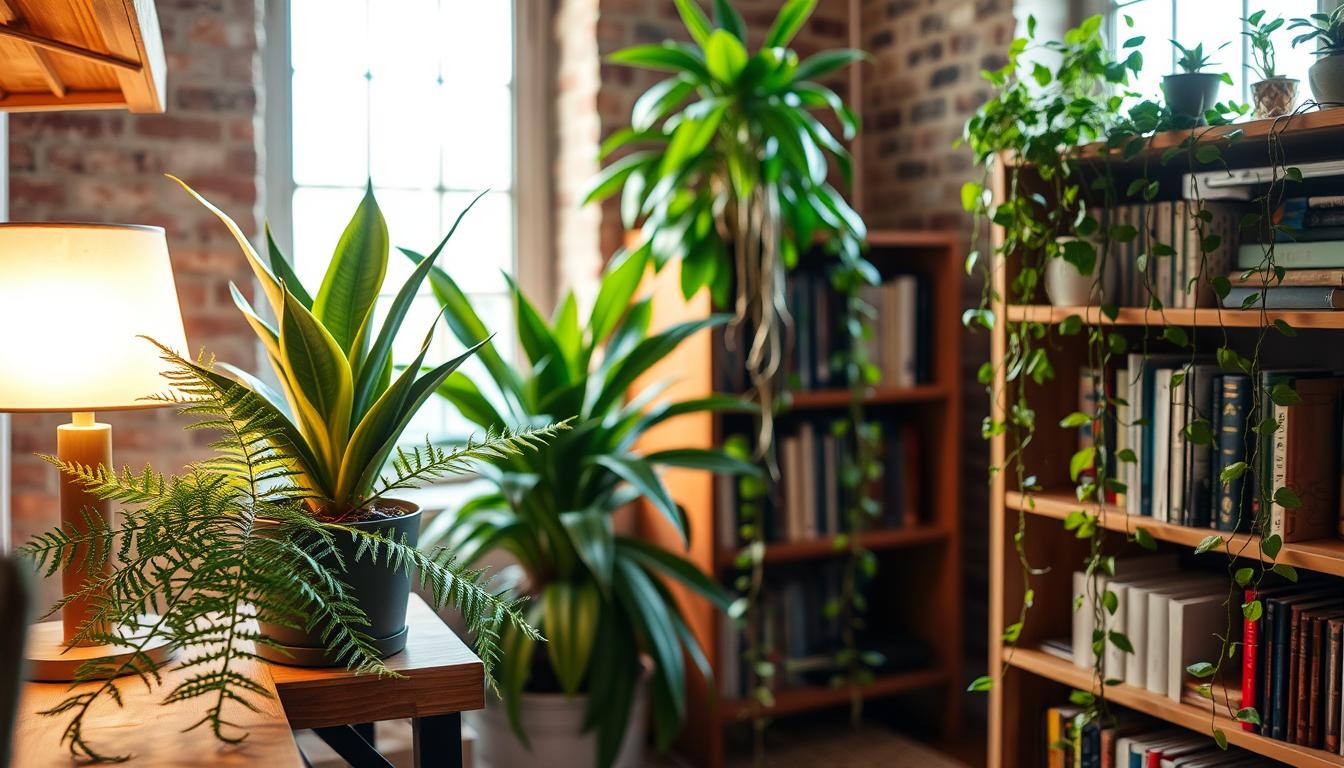Imagine bringing life and freshness to your home, even in dark spots. Indoor plants that don’t need much light are perfect for this. They thrive in low light, ideal for rooms with little sun or partial shade.
There are over 35 indoor plants that love low light. You can pick one that fits your space and style. From easy-care plants like the Snake Plant to beautiful bloomers like the Peace Lily, there’s something for everyone.

Table of Contents
Introduction to Low-Light Indoor Plants
Adding greenery to your home doesn’t need a lot of sunlight. Low light houseplants are great for places with little daylight. They clean the air and boost your mood.
Popular plants like the Snake Plant, Pothos, and ZZ Plant do well in the shade. They’re perfect for rooms with few windows or for those who forget to water.
Knowing what your plants need is key. Most low-light plants like well-draining soil and need little fertilizer. Don’t overwater them. Let the soil dry a bit before watering again. With the right care, these plants can brighten even the darkest spots in your home.
Adding plants that thrive in low light makes your home more welcoming and healthy. They can purify the air, lift your mood, or just add some green. These plants are easy to care for and can grow well in shaded areas. They’re ideal for anyone wanting to bring nature indoors.
Popular Indoor Plants That Thrive in Low Light
Finding low light tolerant plants for your home can be tough. But, there are many low light indoor plant options that can brighten up your space.
Here are some popular low light indoor plant options:
- Snake Plant (Sansevieria): known for its ability to survive with minimal sunlight
- ZZ Plant (Zamioculcas zamiifolia): can survive without natural light and requires minimal watering
- Pothos (Epipremnum aureum): can grow in low light conditions and requires infrequent watering
- Peace Lily (Spathiphyllum): can thrive in low light conditions, but may require more frequent watering
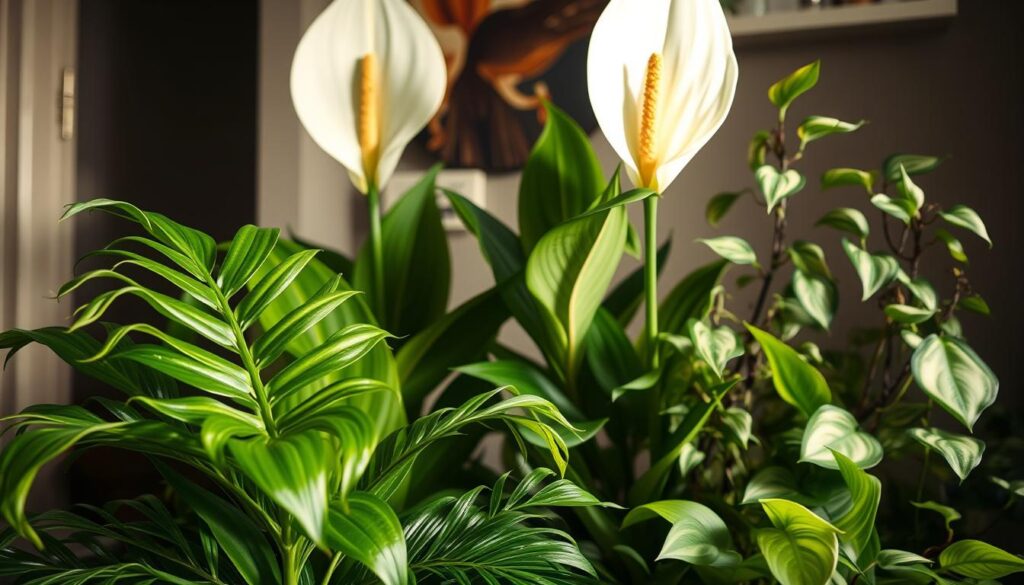
These low light tolerant plants are great for places with little natural light. They bring beauty and freshness to your home.
Caring for Low-Light Plants
Understanding the needs of indoor plants that do not need light is key. Low light indoor plants are great for areas with little natural light. They can do well with proper care. Watering is a crucial part of their care.
Don’t overwater, as low light indoor plants need less water. They dry out slower. To know when to water, check the soil moisture. Stick your finger into the soil up to the first knuckle.
If the soil feels dry, it’s time to water. Some plants, like the Peace Lily, need watering about once every two weeks. Others, like the Devil’s Ivy, should be watered when the top two inches of soil are dry.

Fertilizing your low light indoor plants is also important. But fertilize them only once every 2-3 months during the growing season. By following these tips, you can keep your plants healthy and thriving.
Where to Place Low-Light Plants in Your Home
Choosing the right spot for low light houseplants is key. These plants can handle as little as 50-75 foot candles of light. This makes them great for rooms with little sunlight, like bedrooms and hallways. You can also add artificial light to help them get enough light.
East- or west-facing windows are best for indoor plants. They offer medium bright, indirect light. North-facing windows work well too, especially for plants like the Snake Plant or ZZ Plant. Remember, the size of the window and any blocks can change how much light your plants get.
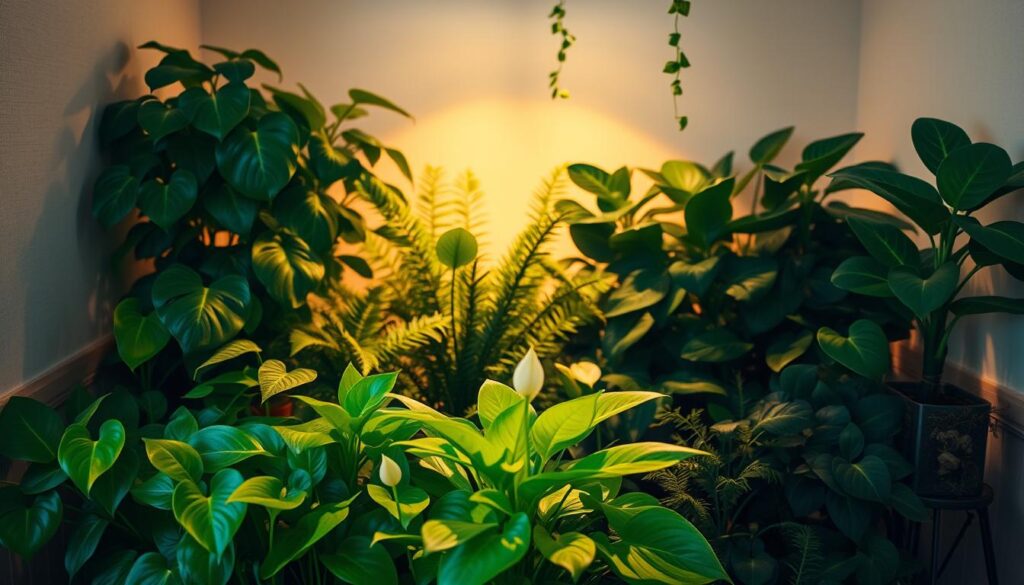
Use vertical space, like a trellis or wall-mounted planter, to make the most of light. You can also set up a plant display on a shelf or side table. This way, you can enjoy low light houseplants in your home.
Plants like Pothos and Peace Lily do well in low light. They’re perfect for rooms with little natural light. By picking the right spot for each plant, you can create a beautiful, easy-to-care-for indoor garden.
Choosing the Right Pot for Your Low-Light Plants
Choosing the right pot for your low light plants is key. The right pot can greatly affect your plants’ health and look. With many options, picking the perfect pot can be tough.
A good pot should drain well, breathe, and hold moisture. Low light plants need soil that drains well to avoid root rot. Look for pots made from ceramic, terracotta, or concrete. These materials let air in and control moisture well.
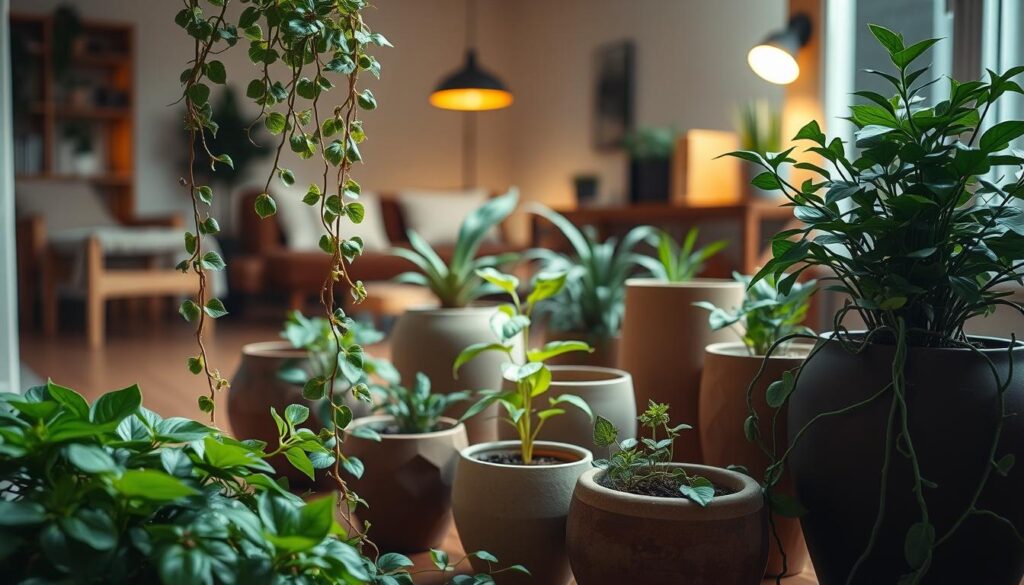
- Size: Choose a pot that matches your plant’s size.
- Material: Pick a material that fits your plant’s needs, like ceramic or terracotta.
- Drainage: Make sure the pot has enough holes for water to drain.
By picking the right pot, your low light plants will do well. They’ll add beauty and freshness to your home. Whether you’re new to plants or experienced, choosing the right pot is crucial for your plants’ care.
Identifying Low-Light Plant Alternatives
There are many indoor plants that don’t need much light. These plants are great for rooms with little sunlight. They help clean the air and bring some green into your home. Plants like the spider plant and peace lily are good choices for low-light spots.
If you have pets, it’s important to pick plants that are safe for them. The prayer plant and parlor palm are safe for pets and look beautiful. The Chinese evergreen and cast iron plant are also good choices. They can handle low light and need very little care.

Other plants that do well in low light include:
* Boston ferns, which like low light and high humidity
* Heartleaf philodendrons, which can handle dimmer areas
* Pothos, which thrive in low light and high humidity
These plants are perfect for places like bathrooms, bedrooms, or any room with little sunlight.
Propagation Techniques for Low-Light Plants
There are easy ways to grow low light houseplants. You can use cuttings, division, or layering. The best time for cuttings is early spring. But, most plants can be grown any time of the year.
Choosing the right soil is key for growing new plants. Perlite, sand, and coarse sphagnum moss are good choices. They hold water and air well, helping roots grow. Mixing these soils, like sand with peat moss, can also work well.
For successful growth, plants need the right conditions. High humidity helps, which you can get by covering pots. Plants need 4 to 6 hours of bright, indirect light. The air should be between 65°F and 75°F for best growth.
Some plants, like pothos and philodendrons, can grow in water. This is because they’re used to swampy environments. Growing them in water is fun and easy. With the right care, you can have a beautiful collection of low light plants.
Decorating with Indoor Plants
Decorating with indoor plants offers many choices, like low light tolerant plants and options for low light spaces. Mixing plants with different textures and colors can make your space more interesting. This approach adds depth and makes your home feel welcoming.
Popular plants for low light include the Peace Lily, Snake Plant, and ZZ Plant. These plants are easy to care for and do well in dim light. Pairing them with woven baskets or ceramic pots adds more interest to your display.
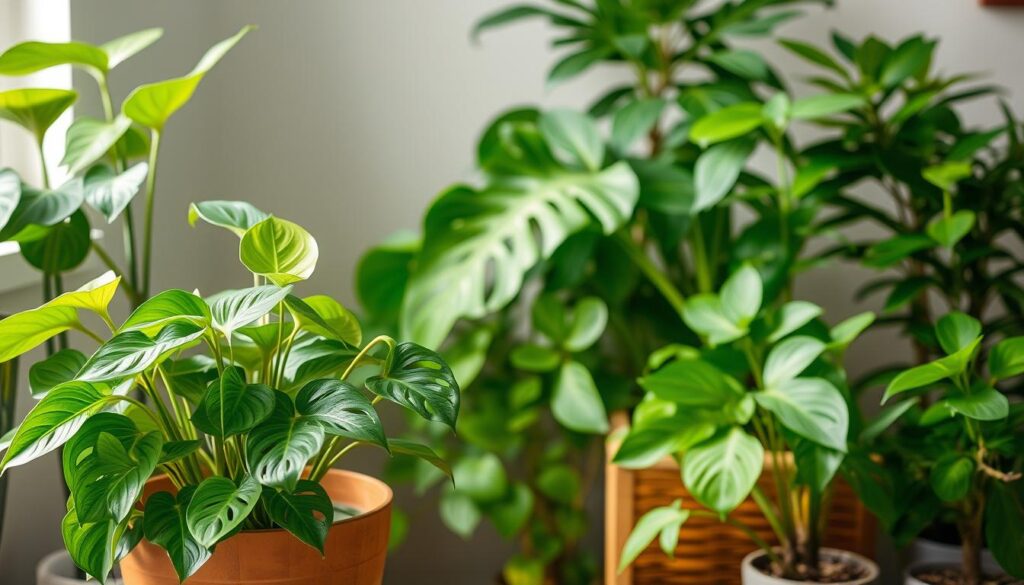
Playing with color schemes can also make your plant display stand out. Use plants with different leaf colors, like the Calathea or Coleus, to brighten your space. Choose planters and pots in various colors and textures to enhance your display.
To make the most of your space, use vertical areas like hanging planters or wall shelves. Plants can also help define different areas, like a reading nook or office. By picking the right plants and mixing them with textures and colors, you can create a stunning display that beautifies your home.
Trouble Signs in Low-Light Plants
When you care for indoor plants that don’t need much light, it’s key to spot trouble signs. These plants can get stressed if they don’t get enough light. This stress can cause yellow leaves, often from too little light or too much water.
Another sign is when plants grow too long and weak. This happens when they stretch for light. To fix this, rotate and prune your plants to help them grow fuller. Regular inspection of your plants is crucial to catch any potential problems early on.
Some common issues that can affect low light indoor plants include:
- Insufficient light, leading to slow growth or no growth at all
- Overwatering, which can cause root rot and other problems
- Pests, such as spider mites, that thrive in low light and high humidity
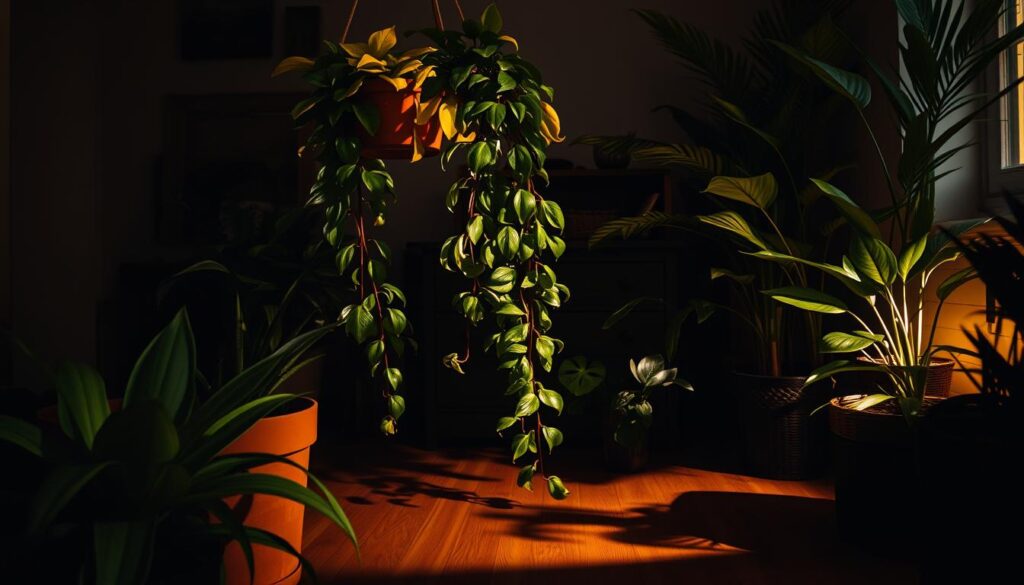
By knowing these potential problems and taking steps to fix them, you can help your indoor plants thrive. This will bring joy and beauty to your home.
Resources for Plant Care Enthusiasts
If you love plants and want to learn more, there are many great resources out there. You can find books, guides, and online communities that are full of helpful tips. These resources will help you take care of your low-light houseplants and more.
Recommended Books and Guides
Begin by reading books like “The Complete Houseplant Survival Manual” by Barbara Pleasant. It covers many indoor plants and how to care for them. Another great book is “Succulents Simplified” by Debra Lee Baldwin. It focuses on the special needs of succulents, which love low light.
Online Communities and Forums
Connecting with other plant lovers is very helpful. Join groups like the r/houseplants subreddit or the Houseplant Hobbyist Facebook group. These places are full of advice, tips, and support for your indoor garden.
Your Local Plant Nursery
Don’t forget to visit your local plant nursery. The staff there can give you personalized advice on choosing the right plants. They can also teach you how to care for them. Building a relationship with your local nursery can really help your plant-growing journey.
FAQ
What are the benefits of low-light indoor plants?
Low-light indoor plants clean the air, boost mental health, and add beauty to homes with little sunlight.
How can I determine the right amount of light for my indoor plants?
Knowing your home’s light is key to picking the right plants. Choose plants that match your home’s light conditions.
What are some popular low-light indoor plants?
Popular plants include snake plants, ZZ plants, pothos, and peace lilies. They’re great for homes with less light.
How do I care for my low-light indoor plants?
Caring for these plants means watering right, fertilizing, and avoiding mistakes. Prune, repot, and watch for pests to keep them healthy.
Where should I place my low-light indoor plants in my home?
Place them in rooms, vertical spaces, or display areas with the right light. This meets their needs and looks good.
How do I choose the right pot for my low-light indoor plants?
Choose a pot based on material, drainage, and looks. Pick one that fits your style and your plants’ needs.
What are some alternative low-light indoor plant options?
There are many alternatives, like air-purifying plants, pet-safe ones, and unique species. They can add variety to your home.
How can I propagate my low-light indoor plants?
Propagating involves simple methods and timing. It’s a way to grow more of your favorite plants.
How can I decorate with low-light indoor plants?
Decorating means mixing textures, colors, and seasonal arrangements. It’s about creating a beautiful display with your plants.
How can I identify and address common problems with my low-light indoor plants?
Watch for stress signs, solve common issues, and know when to replace plants. This keeps them healthy and brightens your home.
Source Links
- 35 Low-Light Indoor Plants That’ll Thrive in the Colder Months – https://www.housebeautiful.com/lifestyle/gardening/g2628/low-light-houseplants/
- 35 Low-Light Indoor Plants for Your Home – https://www.thespruce.com/low-light-conditions-houseplants-1902917
- 10 Best Low-Light Houseplants That Purify Your Home’s Air Naturally – https://www.cnet.com/home/kitchen-and-household/10-best-low-light-houseplants-that-purify-your-homes-air-naturally/
- Top 6 low light indoor plants that are ideal for homes & offices – https://www.plantvault.com/blogs/blog/top-6-low-light-indoor-plants-that-are-ideal-for-homes-offices
- Understanding Light for House Plants: Types of Light and How to Measure – https://savvygardening.com/light-for-house-plants/
- 6 Best Low-Maintenance Indoor Plants for Offices with Low Lighting – https://www.plantplan.co.uk/blog/low-maintenance-indoor-plants-for-offices-with-low-lighting
- The Easiest Indoor Plants that Thrive in Low Light – https://roomfortuesday.com/the-easiest-indoor-plants-that-thrive-in-low-light/
- 30 Hard-to-Kill Indoor Plants That Don’t Need Much Sunlight to Thrive – https://www.realsimple.com/home-organizing/gardening/indoor/plants-that-dont-need-sunlight
- 23 Hard-to-Kill Houseplants You Can Grow Even If You Don’t Get Much Sun (We Promise) – https://www.thespruce.com/plants-that-dont-need-sun-8546874
- 10 of the best low light indoor plants – https://www.bhg.com.au/garden/10-of-the-best-low-light-indoor-plants/
- 30 Best Low-Light Plants That Will Brighten up the Dim Corners of Your Home – https://www.womansday.com/home/decorating/g60763194/best-low-light-indoor-plants/
- Top 6 low light indoor plants that are ideal for homes & offices – https://www.plantvault.com/blogs/blog/top-6-low-light-indoor-plants-that-are-ideal-for-homes-offices?srsltid=AfmBOorMwrHQf5E5VEATkMnVRLrghF7uCn0I-KBufB7NRFuGfqHEILFS
- The Sill | How to Choose a Houseplant Based on Your Light – https://www.thesill.com/blogs/care-miscellaneous/understanding-lighting-in-your-home-and-how-it-affects-your-plants?srsltid=AfmBOopjoUeE_TZQ-HskP4oKVl61HNKjBC6OV_cjKuOV_IWujlwWk0bM
- The Best Spots in Your Home to Help Indoor Plants Grow – https://www.cnet.com/home/kitchen-and-household/best-places-for-indoor-houseplants/
- 11 Best Indoor Plants: Complete With Names and Pictures – https://www.almanac.com/best-indoor-plants-low-light
- 14 Low-Light Houseplants That Thrive in Dim Indoor Spaces – https://www.provenwinners.com/learn/houseplants/low-light
- 13 Houseplants That Thrive in Low Light – https://www.marthastewart.com/7973853/low-light-houseplants
- 12 shade-loving houseplants for low-light rooms – Rest Less – https://restless.co.uk/leisure-and-lifestyle/home-garden/shade-loving-houseplants-for-low-light-rooms/
- Flora | Best Plants for Bathroom Spaces with Low or No Light – https://florasense.com/blogs/best-plants-for-bathroom-spaces-with-low-or-no-light/
- How to Propagate Houseplants by Leaf Section Cuttings – https://yardandgarden.extension.iastate.edu/how-to/how-propagate-houseplants-leaf-section-cuttings
- How to Propagate Plants | Propagation for Beginners – https://www.thesill.com/blogs/plant-design-diy/plant-propagation-for-beginners?srsltid=AfmBOorUGgps05N8tjarbelUlI-PreGReNO-s8HEE8v9XhBCN0_RZ9cU
- Best Indoor Plants for Dark Rooms: These Houseplants Need Surprisingly Little Light – https://www.admiddleeast.com/story/best-indoor-plants-for-dark-rooms-these-houseplants-need-surprisingly-little-light
- 6 Chic Ways to Use Plants in Your Home Decor – and Why You Should – https://www.aarp.org/home-family/your-home/info-2024/incorporate-plants-into-home-decor.html
- Are Your Houseplants Getting the Right Light? 6 Signs They Aren’t – https://www.bhg.com/houseplant-lighting-tips-8752403
- Low Light Indoor Plants: The Complete Guide – https://hortology.co.uk/blogs/guides-to-greenery/low-light-indoor-plants-the-complete-guide
- 10 Best Low-Light Indoor Plants – https://www.lowes.com/n/buying-guide/low-light-plants
- How to Use Grow Lights for Houseplants – https://www.thesill.com/blogs/care-miscellaneous/how-to-use-grow-lights-for-houseplants?srsltid=AfmBOooLkLm-hB5msr7xd_LMlEPVUpU726ZIPNqYv69wJ0OB7lgtiBRe

